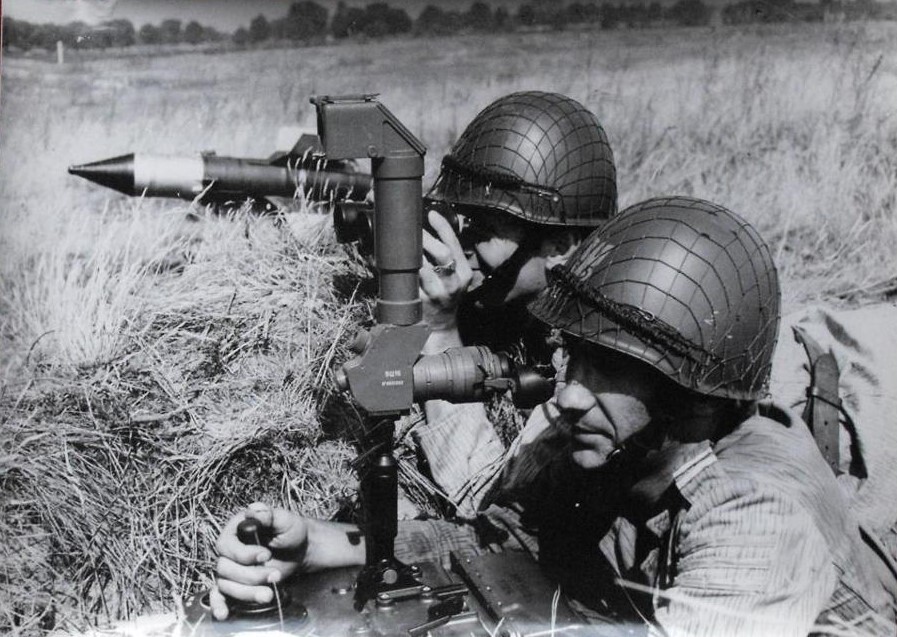from wikipedia:
The 9M14 Malyutka (Russian: Малютка; "Little one", NATO reporting name: AT-3 Sagger) is a manual command to line of sight (MCLOS) wire-guided anti-tank guided missile (ATGM) system developed in the Soviet Union. It was the first man-portable anti-tank guided missile of the Soviet Union and is probably the most widely produced ATGM of all time—with Soviet production peaking at 25,000 missiles a year during the 1960s and 1970s. In addition, copies of the missile have been manufactured under various names by at least six countries.
Although they have been supplanted by more advanced anti-tank guided missiles, the Malyutka and its variants have seen widespread use in nearly every regional conflict since the 1960s and are still kept in large stockpiles and sometimes used to this day by non state actors such as Hezbollah.[7]
The missile can be fired from a portable suitcase launcher (9P111), ground vehicles (BMP-1, BRDM-2) and helicopters (Mi-2, Mi-8, Mi-24, Soko Gazelle). The missile takes about five minutes to deploy from its 9P111 fibreglass suitcase, which also serves as the launching platform.
The missile is guided to the target by means of a small joystick (9S415), which requires intensive training of the operator. The operator's adjustments are transmitted to the missile via a thin three-strand wire that trails behind the missile. The missile climbs into the air immediately after launch, which prevents it from hitting obstacles or the ground. In flight, the missile spins at 8.5 revolutions per second—it is initially spun by its booster, and the spin is maintained by the slight angle of the wings. The missile uses a small gyroscope to orient itself relative to the ground; as a result, the missile can take some time to bring back in line with the target, which gives it a minimum range of between 500 and 800 metres (550 and 870 yd). For targets under 1,000 m, the operator can guide the missile by eye; for targets beyond this range the operator uses the eight-power, 22.5-degree field of view, 9Sh16 periscope sight.
The engagement envelope is a 3 kilometres (1.9 mi) wide, 45-degree arc centered on the missile's launch axis. At ranges under 1.5 kilometres (0.93 mi), this arc reduces until, at the 500 metres (550 yd) range, the missile can only hit targets 50 metres (55 yd) either side of the center line. Accuracy falls off away from the launch axis—falling to approximately half its optimal accuracy at the extremes.
While early estimates of the missile hitting the target ranged from 60 to 90%, experience has shown that it can drop to an efficiency between 2 and 25% in case of less than optimal conditions and lack of skill from the operator. In fact, MCLOS requires considerable skill on the part of the operator, nevertheless, the weapon has always been quite popular with its operators and has enjoyed a constant updating effort both in the Soviet Union/Russia and in other countries.
The two most serious defects of the original weapon are its minimum range of between 500 and 800 metres (550 and 870 yd) (targets that are closer cannot be effectively engaged) and the amount of time it takes the slow moving missile to reach maximum range—around 30 seconds—giving the intended target time to take appropriate action, either by retreating behind an obstacle, laying down a smoke-screen, or by returning fire on the operator.[1]
Later versions of the missile addressed these problems by implementing the much easier to use SACLOS (semi-automatic command to line of sight) guidance system (though only available for ground vehicle and helicopter mounts), as well as upgrading the propulsion system to increase the average flight speed. The latest updates feature tandem-charge warheads or standoff probes to counteract explosive reactive armor, as well as thermal imaging systems. Even in these latest versions, the Malyutka is probably the most inexpensive ATGM in service today.
its man portable:

here it is in position to be used:

you can use it on top of a truck:

you can put it on the barrel of your tank:

you can put a LOT of them on a lighter tank:


here are some pics post launch, but the wires are thin + lightweight enough to be pretty much invisible.
here's a similar but different weapon (a TOW i'm pretty sure) with the wires visible after launch:
So damn cool